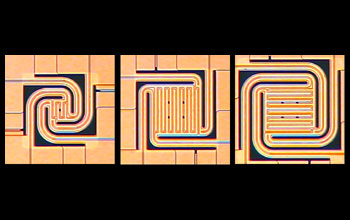Multimedia Gallery
Micro-hotplates
Micro-hotplates crafted of silicon carbide by Boston Microsystems. Each consists of a central plate surrounded by curved tethers. The largest is less than 100 microns (millionths of a meter) across.
These micro-hotplates--capable of reaching temperatures above 1100 degrees Celsius (2012 degrees Fahrenheit)--serve as a critical tool in developing new precision materials, some of which will enable the development of next-generation sensors. Already the devices have led to new oxygen and engine emission sensors.
Boston MicroSystems Inc. crafted the hotplates from silicon carbide because it is a robust material that can tolerate extreme heat and reach peak temperature in less than two-thousandths of a second. The tiny hotplates reside on a microchip within a transparent, polycarbonate chamber that can endure near-vacuum pressures. Ports in the chamber's sides allow gases to pass through to feed experiments, while researchers observe experiments in progress through a microscope.
The techniques necessary for crafting and optimizing these microelectromechanical systems were developed with support from the National Science Foundation Small Business Innovation Research (SBIR) program and SBIR programs at the Department of Energy, the Environmental Protection Agency and NASA. To learn more about this research, see NSF press release 04-900, Searing Heat, Little Package. (Date of Image: 2004)
SORRY: THIS IMAGE IS NOT AVAILABLE IN HIGH-RESOLUTION FORMAT
Credit: Boston Microsystems Inc.
Images and other media in the National Science Foundation Multimedia Gallery are available for use in print and electronic material by NSF employees, members of the media, university staff, teachers and the general public. All media in the gallery are intended for personal, educational and nonprofit/non-commercial use only.
Images credited to the National Science Foundation, a federal agency, are in the public domain. The images were created by employees of the United States Government as part of their official duties or prepared by contractors as "works for hire" for NSF. You may freely use NSF-credited images and, at your discretion, credit NSF with a "Courtesy: National Science Foundation" notation.
Additional information about general usage can be found in Conditions.
Also Available:
Download the high-resolution JPG version of the image. (321 KB)
Use your mouse to right-click (Mac users may need to Ctrl-click) the link above and choose the option that will save the file or target to your computer.



